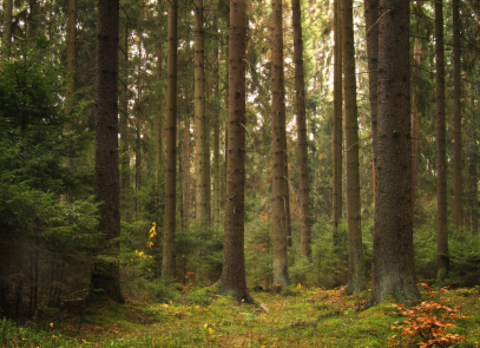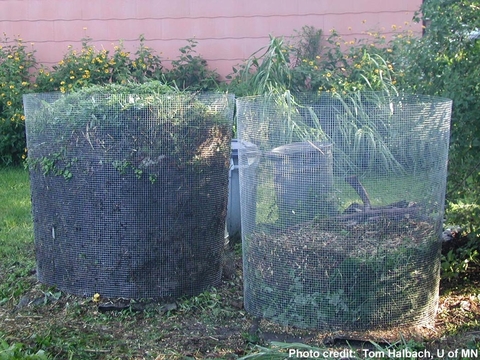Why are shoreland trees important?
Trees and shrubs are an excellent, inexpensive and attractive way to control runoff and erosion.
- Roots hold soil and help stabilize slopes by trapping and using water that would otherwise run off.
- Roots increase soil porosity, allowing water to infiltrate rather than run off.
- Vegetation filters out nutrients and pesticides that could otherwise reach a lake or stream and cause algal blooms or excessive plant growth.
- Trees and shrubs also improve air quality by taking in carbon dioxide and giving off oxygen.
- Trees provide shade and help moderate weather extremes such as hot sun or strong winds.
- Trees and shrubs offer habitat for wildlife.
- Trees and shrubs provide privacy for humans by screening adjacent property.
Why retain existing trees and shrubs?
Natural vegetation is best because:
- Adapted to the local climate.
- Usually has strong, well-established root systems. These root systems provide better erosion control, water-cleaning capacity and stability for plants.
- Offer more typical habitat for wildlife.
- More resistant to pests and disease.
Planning your property development in advance to save existing vegetation is very important. If native trees and shrubs were removed in the past, planting and nurturing replacements will help increase your property value and enjoyment while helping to protect water quality.
Establishing filter strips
Filter strips are vegetated areas of land next to shorelines that help minimize runoff to a lake or stream. The most effective filter strips include a variety of low plants, shrubs and trees, preferably native or existing vegetation.
Research done on agricultural land with filter strips next to water bodies showed that:
- All nitrate was removed from ground water flowing under 90 feet of woods.
- 80% of phosphorus and nitrate was removed from surface runoff.
Thus, filter strips are a wise investment to protect your lake or stream, even on property that is not used for intensive agriculture.
In Minnesota, filter strips of 50-150 feet are recommended for most effective water quality protection. For new development, the required width for filter strips depends on how a lake or river is classified. Contact your local zoning official for information on classifications. Re-establishing vegetative strips along the shore of developed property is also recommended.
Even a few feet of filter strip will help minimize runoff and provide some water quality protection.
Best management practices (BMPs) for trees
Existing trees
During construction:
- Protect bark, limbs and roots during construction.
- Tie planks around trees to protect them from equipment.
- Don't drive or park equipment over the root area.
Safeguard roots because they are the most important part of a tree:
- Avoid filling, compacting, or removing soil from the root area.
- Root area is at least as large as the area under the crown of a tree.
Maintain trees properly:
- Trim dead and dying limbs and remove diseased growth, but never trim oaks between April 15 and July 1 because of risk of oak wilt.
- Properly dispose of diseased limbs and bark to avoid providing an opportunity for the disease to spread.
- Scout for pests and diseases; treat early to avoid widespread damage.
- Water during times of low rainfall; trees should receive 1 inch of water per week.
- When trees are too crowded, remove some to allow more light and water to reach other remaining stems.
- Contact your local zoning office for restrictions related to thinning trees in the shoreland area.
Establishing new trees
- Use native species when available because they are hardier, more resistant to disease and pests, and provide natural habitat for wildlife.
- Include a variety of trees and shrubs; emphasize diversity of species, heights and ages.
- Plant in the spring or fall.
When planting:
- Dig a hole 1 to 2 feet wider than the root system.
- Backfill with original soil.
- Water root area thoroughly.
- Add a 3- to 6-inch layer of mulch.
- Stake only if necessary.
Nurture new vegetation (simply planting a tree is not enough to ensure it will survive):
- Water regularly and deeply. Avoid short, frequent watering because it promotes shallow root systems.
- Fertilize and prune as necessary.
- Provide winter protection.
Suggested species for Northeastern Minnesota
Hardwoods
Red maple (Acer rubrum) - Needs full sun, well-drained soil with ample moisture; intolerant of poorly aerated soils, high pH, and hot, dry site conditions; gray squirrels eat the buds and seeds in late winter/early spring.
Silver maple (Acer saccharinum) - Fast-growing, large size; needs full sun; tolerates a wide range of soil types but prefers deep moist soil; large vigorous root systems; seeds prolifically.
Sugar maple (Acer saccharum) - Needs fertile, well-drained soil with ample moisture; full sun or partial shade; grows poorly in compacted soils.
Paper birch (Betula papyrifera) - Prefers well-drained soil and cool, moist conditions; full sun; needs irrigation and fertilization to stay vigorous; intolerant of compacted soil, dry conditions, and high temperature.
River birch (Betula nigra) - Needs fertile, slightly acidic soil; transplant in spring only; susceptible to birch leaf miner (skeletonizes leaves).
Black ash (Fraxinus nigra) - Needs full sun and ample soil moisture; tolerates poorly drained areas.
Green ash (Fraxinus pennsylvanica) - Needs full sun, but well adapted to a variety of soil types; easily established; pruning may be needed to improve form.
Swamp white oak (Quercus bicolor) - Tolerant of heavy soils with poor drainage; likes acidic soils; drought tolerant; specify swamp white oak if purchasing, because white oak doesn't do well in northeastern Minnesota.
Northern pin oak(Quercus ellipsoidalis) - Prefers sandy soil and full sun; drought tolerant.
Burr oak (Quercus macrocarpa) - Large tree tolerant of a wide range of soil conditions; likes full sun.
Northern red oak (Quercus rubra) - Tolerant of a wide range of site and soil conditions but needs well-drained soil; faster growing oak; don't prune April through July.
Laurel leaf willow (Salix amygdaloides) (also known as peach leaf willow) - Tolerant of a wide range of sites, even poorly drained areas.
Black willow (Salix nigra) - Likes moist site, otherwise not demanding of site conditions; needs frequent pruning.
Weeping willow (Salix babylonica) - An introduced species that does well in northern Minnesota.
Linden (American basswood) (Tilia americana) - Tolerant of a wide range of soils but prefers well-drained soil with ample moisture; will grow on clay soils.
Conifers
Balsam fir (Abies balsamea) - Needs rich, well-drained soil with adequate moisture; intolerant of hot, dry conditions.
Larch/tamarack (Larix laricina) - Performs well on a variety of sites; tolerant of poorly drained soils and dry sites; loses its foliage each year.
White spruce (Picea glauca) - Tolerates a wide range of soil conditions but prefers moist, well-drained soil; likes full sun.
Black spruce (Picea mariana) - Tolerates a wide range of soil conditions, including wet areas.
Norway nine (Pinus resinosa) - Needs full sun; tolerates dry, sandy acidic soils; intolerant of compacted or poorly drained soils.
Eastern white pine (Pinus strobus) - Fast-growing species, grows well on heavy or sandy acidic soil; must be managed to prevent loss to white pine blister rust which is especially prevalent in shoreland areas; a favorite of deer and red squirrels.
Northern white cedar (Thuja occidentalis) - Suitable for shorelines and low wet areas; very shade tolerant; a favorite of deer and rabbits.
Shrubs
Alder (Alnus sp.) - Likes moist, cool soil; full sun or partial shade; good for wet soil sites.
Serviceberry (juneberry) (Amelanchier sp.) - Needs well-drained soil; full sun or moderate shade.
Gray dogwood (Cornus racemosa) - Tolerant of a wide range of soil moisture and fertility conditions; full sun or partial shade.
Red-osier dogwood (Cornus stolonifera) - Tolerant of a variety of soil types, but does not like hot, droughty conditions; full sun or light shade.
American hazel (Corylus americana) - Needs moist fertile soil; full sun or partial shade; intolerant of dry areas; squirrels and bears use the nuts.
winterberry (Ilex verticillata) - Needs moist, acidic soil; prefers full sun; grows well in wet soil near ponds or streams.
Chokecherry (Prunus virginiana) - Prefers well-drained soil with ample moisture.
Sumac (Rhus typhina) - Tolerates poor, dry soils; prefers full sun.
Willow (Salix sp.) - Various varieties; smaller types good for stabilizing banks; pussy willows like moist soils and tolerate wet areas; prefers full sun.
Viburnum (Cranberry) (Viburnum sp.) - Likes rich soils with ample moisture; sun or shade.
BMPs for maintaining shoreland vegetation
Adding and maintaining a filter strip will help preserve water quality. Follow these guidelines as you care for near-shore vegetation:
- Rake dead leaves and brush away from the water. Compost vegetation in a sturdy structure away from the shoreline.
- Never dump leaves or vegetative debris into a lake or stream because this releases nutrients and organic acids into the water.
- Avoid burning on the beach or near shore because the remaining ash is highly alkaline and may change the pH of the lake and promote growth of undesirable plants.
- Use lake water for irrigating trees, shrubs and lawns. Lake water usually can supply the nutrients your near-shore vegetation needs to promote healthy growth.
- Use chemicals responsibly when treating diseases or insect pests. If using, only use the required amount.
Encouraging wildlife
Planting certain trees and shrubs will attract wildlife to your property and enhance your enjoyment. When planting to encourage wildlife keep in mind:
- The need for shelter and habitat as well as food.
- Offer a diversity of plants with flowers, fruits, nuts or cones.
- Include deciduous as well as evergreen species.
For more information, contact the MN Department of Natural Resources (DNR) Area Wildlife Manager or your county office of the University of Minnesota Extension.
Regulations that apply
Filter strips are required on all new shoreland property development. The width depends on slope and lake or river classification, but the minimum requirement is 38 feet. Some local zoning ordinances may be more restrictive than the minimum state regulations, so check with your local zoning office for requirements in your area.
For more information
County offices:
Regional offices of MN State agencies:
- MN Department of Natural Resources, Division of Fish and Widlife (DNR)
- MN Board of Water and Soil Resources (BWSR)
Federal agencies:
Reviewed in 2018



